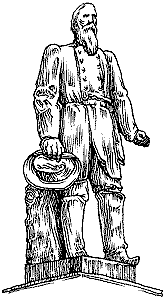“When fascism comes to America, it will not be in brown and black shirts. It will not be with jack-boots. It will be Nike sneakers and Smiley shirts.
— George Carlin
I first noticed the statue in McDowell Park about the time I started to walk around Danville after we got the Town House. There was something about the artistic interpretation that appealed to me — not entirely realistic, but only slightly abstracted from life, perhaps like the way I might draw something. I reacted to it as sculpture before I thought much about it as a Confederate symbol. Eventually I did draw it. I don’t remember the year, although I could look it up. At any rate, it was a long time before tragic events were used as an excuse to denounce antique works of art. As soon as they were condemned elsewhere, I thought, “Danville seems immune to such things, but it’s only a matter of time before that statue becomes a target for destruction or removal.” My recent conversation with a local artist has informed me that the day has finally arrived. The decision to spend a lot of money to truck it off apparently has sparked a firestorm within the church congregation with jurisdiction over the statue, which is probably about a hundred years old. I once heard that it’s the northernmost Confederate memorial, but I can’t see how that would be possible. It is understandable that with the Perryville Battlefield only a few miles away, and the history of the conflict’s effect on Danville, that there would be a monument here to honor dead CSA soldiers. More than that, it is a work of art. Period. It was created as such, and is part of of American, Kentucky, and Danville history. It makes sense to preserve it, to conscientiously interpret it, and to put it into the context of the times. Some are certain to have found it offensive, most likely from the time it was erected, and I can respect that, but it is very dangerous territory to use that as justification for the censorship or desecration of art. The whole thing brings a wave of sadness over me. I doubt that those who oppose the decision will successfully swim against a strong tide of political correctness. When the relocation takes place, I hope it ends up north of town, over at the Danville National Cemetery, near the graves of southern men who were buried far from their homes.
My recent conversation with a local artist has informed me that the day has finally arrived. The decision to spend a lot of money to truck it off apparently has sparked a firestorm within the church congregation with jurisdiction over the statue, which is probably about a hundred years old. I once heard that it’s the northernmost Confederate memorial, but I can’t see how that would be possible. It is understandable that with the Perryville Battlefield only a few miles away, and the history of the conflict’s effect on Danville, that there would be a monument here to honor dead CSA soldiers. More than that, it is a work of art. Period. It was created as such, and is part of of American, Kentucky, and Danville history. It makes sense to preserve it, to conscientiously interpret it, and to put it into the context of the times. Some are certain to have found it offensive, most likely from the time it was erected, and I can respect that, but it is very dangerous territory to use that as justification for the censorship or desecration of art. The whole thing brings a wave of sadness over me. I doubt that those who oppose the decision will successfully swim against a strong tide of political correctness. When the relocation takes place, I hope it ends up north of town, over at the Danville National Cemetery, near the graves of southern men who were buried far from their homes.
Each time the Taliban or other radical groups obliterate Buddhist artworks deemed objectionable, it would appear to a reasonable person, on the face of it, as an abomination. When art historian Robert Hughes describes Stalin’s repression of the Russian avant-garde after 1930, he writes that, “as a wholesale trashing of a civilization, only Hitler’s demolition of the German modernists compares with it.” Although I’m not holding my breath, it will remain my hope that American culture warriors with a self-righteous upper hand are not embarking on an enterprise that people in the future will classify as yet another ideological outrage.